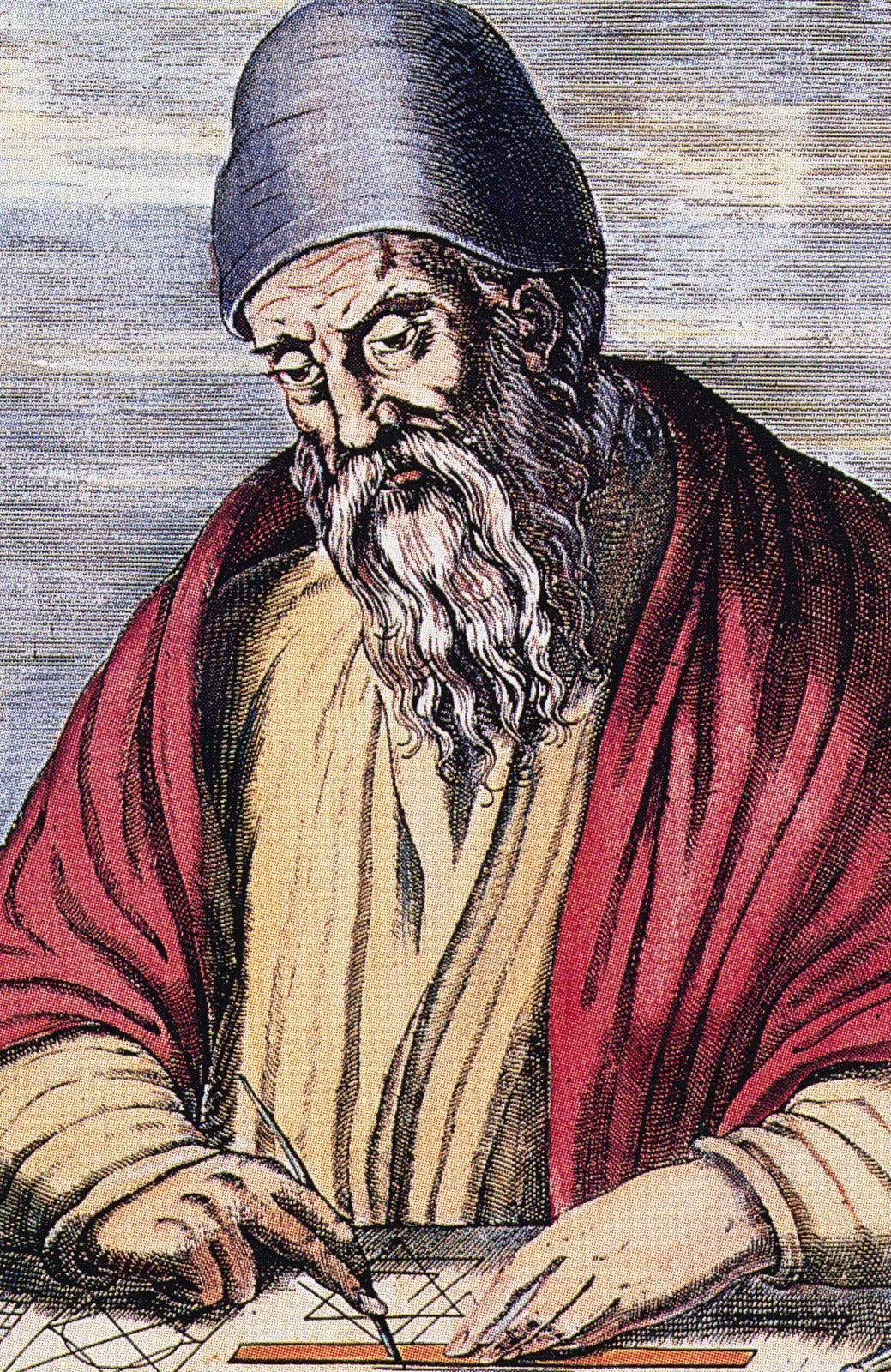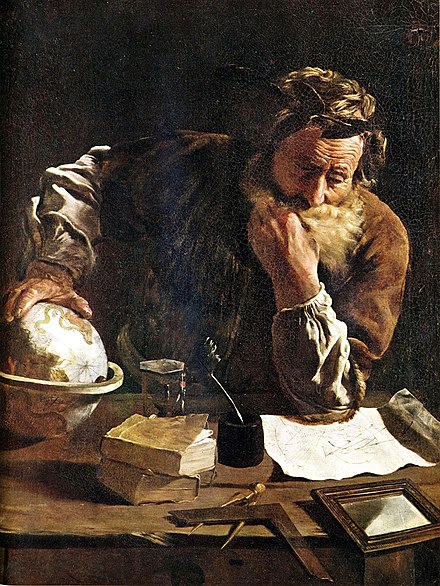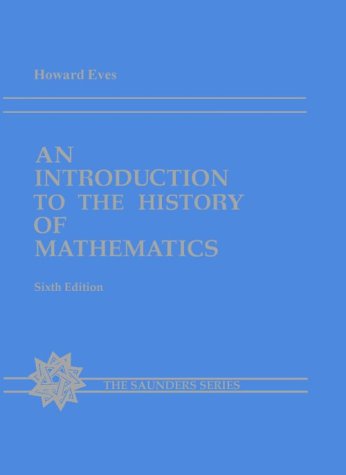 Euclid of Alexandria (circa 325 BCE-circa 265 BCE) |
 Archimedes of Syracuse (287 BCE-212 BCE) |
 Isaac Newton (January 4, 1643-March 31, 1727) |
 Euclid of Alexandria (circa 325 BCE-circa 265 BCE) |
 Archimedes of Syracuse (287 BCE-212 BCE) |
 Isaac Newton (January 4, 1643-March 31, 1727) |
COURSE: MATH 3040
TIME: TBA, PLACE: TBA
INSTRUCTOR: Dr. Robert Gardner, OFFICE: Room 308F of Gilbreath Hall
OFFICE HOURS: TBA, PHONE: 439-6979 (Math Office 439-4349)
E-MAIL: gardnerr@etsu.edu
WEBPAGE: Dr. Bob's faculty webpage
TEXT: An Introduction to the History of Mathematics, 6th edition, Howard Eves (Saunders, 1990).

PREREQUISITES: Linear Algebra (MATH 2010), Calculus 3 (MATH 2110), and Mathematical Reasoning (MATH 3000).
CLASS NOTES: Online notes are available and the lecture component of the class will be based on these notes. Limited marginal notes, additional examples, and homework hints will be given using a document camera and handwritten material. Class notes are online, based on the two parts of the book: History of Mathematics before 1600 and History of Mathematics after 1600. You should read through the online notes as best you can before each class. These notes are extensive and go well beyond what is covered in the textbook! We will not cover all the details in the online notes. You will get additional information on the topics from the Problem Studies in the book, some of which will be given as homework.
ZOOM AND ATTENDANCE: A Zoom meeting and recording of each class will be available. However, you are expected to attend in-person! In-person attendance will be informally taken during each class. If you are not feeling well or for other reasons cannot attend, let me know before class starts. The recordings will be available (if all of the technology works) and you can view them (or re-view them) as needed.
ABOUT THE COURSE: The course description as given in the 2024-25 Undergraduate Catalog is: "Studies mathematics and those who contributed to its development. Recommended for teachers and those desiring to expand their view of mathematics." In keeping with the History Department's "World History to 1500" (HIST 1110), we will likely cover a similar trime frame. Much of our time will be spent on the work of the ancient Greeks. We will try to cover most of the material up 1600. This will likey leave little time for post-1600 history, but we'll try to squeeze in the material on Descartes (since Cartesian coordinates play such a central role in highschool and college math) and on Calculus (also possibly a highschool topic, and certainly a freshman college-level topic). This latter material includes topics which, if you are teaching-bound, you are likely to teach.
A COMMENT ON DIVERSITY: The course will be largely concerned with the development of mathematics in the Mediterranean and Europe, and contributions made by men. Sincere attempts will be made to include the contributions from other cultures and by women. Eves' book includes a chapter on "Chinese, Hindu, and Arabian Mathematics" (Chapter 7) and a few mentions of women mathematicians, but not many. The online notes include material on women and minorities. Computational techinques of native Americans will be mentioned and, since we are in East Tennessee, we'll take a look at the numerals introduced by Sequoyah when he created his syllabary for the Cherokee langauge.
GRADING: Homework will be assigned on a regular basis (weekly). There will be a midterm exam and a (noncomprehensive) final exam. Your grade will be computed based on your performance on these in a way yet to be determined. Grades will be assigned based on a 10 point scale with "plus" and "minus" grades being assigned as appropriate (which means, based on how the university assigns grade points, 3 point intervals for plus and minus grades - for example, an A- corresponds to percentage grades of 90, 91, and 92).
HOMEWORK: Homework will be assigned and collected at one week intervals. It will normally be due on Saturdays at midnight and you will be expected to submit scans in PDF of your work to D2L (so you will need a way to convert your solutions into PDF versions, either with a scanner of a phone APP). YOU MUST SHOW ALL DETAILS ON THE HOMEWORK PROBLEMS!!! Justify every step and claim you make - this is how you convince me that you know what you are doing. Hints on the homework problems will be given in class and you will be required to follow those hints (and the notation used in the hints) in your solutions. You may find some answers online, but these rarely sufficiently justify all steps and are unacceptable as homework solutions.
DESIRE2LEARN: I will not rely on the Desire2Learn ("elearn") website for classnotes or supplements. Instead, I will simply post this material directly on the internet. However, I will post your homework grades, homework solutions, test grades, and recordings of class lectures on D2L.
SYLLABUS ATTACHMENT: You can find an on-line version of the university's syllabus attachment (which contains general information concerning advisement, honor codes, dropping, etc.; last accessed 8/18/2024).
TENTATIVE OUTLINE:
Chapter 1. Numerical Systems. Number bases, finger numbers and body numbers, written numbers (Egyptian, Roman, Babylonian, Cherokee), multiplicative grouping systems, positional numeral systems, the Hindu-Arabic numeral system.
Chapter 2. Babylonian and Egyptian Mathematics. Babylonian sources, Babylonian geometry, Babylonian algebra, the Babylonians an Pythagorean triples, Egyptian sources, Egyptian algebra, Egyptian geometry, the Rhind Papyrus.
Chapter 3. Pythagorean Mathematics.
Mathematical proof, Proclus' commentary on Eudeus' History of Geometry and pre-Euclid geometry, Pythagoreas and the Pythagoreans, "Men of Mathematics/Women of Mathematics," Pythagorean Theorem and triples, irrational magnitudes, algebraic identities and geometric proofs, quadratic equations, regular solids.
Chapter 4. Duplication, Trisection, and Quadrature.
Plato's Academy and Platonism, Zeno's paradoxes, Euclidean tools and the three famous problems (duplication of the cube, trisection of an angle, squaring the circle), the idea of a discontinuous model of Euclidean geometry based on compass and straightedge restrictions), a history of π.
Chapter 5. Euclid and his Elements.
Alexandria Egypt, Euclid and his Elements, Johan Heiberg and Thomas Heath, Eudoxus and the method of exhaustion, content of the Elements, Euclid's thory of proportion, regular polygons, Euclid's other works.
Chapter 6. Greek Mathematics After Euclid.
Archimedes, Archimedes' Method, Archimedes' method of equilibrium, Eratosthenes, Apollonius and conic sections, Hipparchus, Ptolemy, Greek trigonometry, Heron, Greek algebra, Diophantus, Pappus, Theon, Hypatia.
Chapter 7. Chinese, Hindu, and Arabian Mathematics.
China, Indian arithmetic and algebra, Indian geometry and trigonometry, Brahmagupta, Arabic arithmetic and algebra, Arabic geometry and trigonometry, the transmission through the Arabic world.
Chapter 8. European Mathematics, 500 to 1600.
Fibonacci, Liber abbaci, Regiomontanus and trigonometry, the arithmetics, algebraic symbolism, cubic and quartic equations, Tartaglia, Cardano, Viete.
Chapter 10. Analytic Geometry and Other Precalculus Developments. (Covered Partially)
Analytic geometry and Descartes.
Chapter 11. The Calculus and Related Concepts.
The beginnings of integration, Cavaleri and indivisibles, differentiation, Wallis, Barrow, Newton and Leibniz and the "Calculus Wars."
IMPORTANT DATES: (see the official ETSU calendar for more details; accessed 8/18/2024). Specific dates are TBA.
| |
|
|||
| |
||||
Return to Bob Gardner's home page
Last updated: November 28, 2024